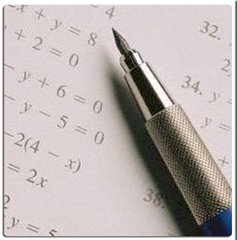Saturday, October 26, 2013
Tuesday, April 14, 2009
GRE SENTENCE COMPLETION OF THE DAY
A. Skin, Abyss
B. Skin, Craven
C. Skin, Storm
D. Hide, Abyss
E. Hide, Storm
GRE GRAPH QUESTION OF THE DAY
A. 358
B. 390
C. 407
D. 540
E. 716
2. Which year did the same number of boys and girls attend the conference?
A. 1995
B. 1996
C. 1997
D. 1998
E. None
3. Which two years did the least number of boys attend the convention?
A. 1995 and 1996
B. 1995 and 1998
C. 1996 and 1997
D. 1996 and 1992
E. 1997 and 1998
GRE READING PASSAGE OF THE WEEK
Many great inventions are greeted with ridicule and disbelief. The invention of the airplane was no exception. Although many people who heard about the first powered flight on December 17,1903, were excited and impressed, others reacted with peals of laughter. The idea of flying an aircraft was repulsive to some people. Such people called Wilbur and Orville Wright, the inventors of the first flying machine, impulsive fools. Negative reactions, however, did not stop the Wrights. Impelled by their desire to succeed, they continued their experiments in aviation.
Orville and Wilbur Wright had always had a compelling interest in aeronautics and mechanics. As young boys they earned money by making and selling kites and mechanical toys. Later, they designed a newspaper-folding machine, built a printing press, and operated a bicycle-repair shop. In 1896, when they read about the death of Otto Lilienthal, the brother's interest in flight grew into a compulsion.
Lilienthal, a pioneer in hang-gliding, had controlled his gliders by shifting his body in the desired direction. This idea was repellent to the Wright brothers, however, and they searched for more efficient methods to control the balance of airborne vehicles. In 1900 and 1901, the Wrights tested numerous gliders and developed control techniques. The brothers' inability to obtain enough lift power for the gliders almost led them to abandon their efforts.
After further study, the Wright brothers concluded that the published tables of air pressure on curved surfaces must be wrong. They set up a wind tunnel and began a series of experiments with model wings. Because of their efforts, the old tables were repealed in time and replaced by the first reliable figures for air pressure on curved surfaces. This work, in turn, made it possible for them to design a machine that would fly. In 1903 the Wrights built their first airplane, which cost less than one thousand dollars. They even designed and built their own source of propulsion- a lightweight gasoline engine. When they started the engine on December 17, the airplane pulsated wildly before taking off. The plane managed to stay aloft for twelve seconds, however, and it flew one hundred twenty feet.
By 1905 the Wrights had perfected the first airplane that could turn, circle, and remain airborne for half an hour at a time. Others had flown in balloons or in hang gliders, but the Wright brothers were the first to build a full-size machine that could fly under its own power. As the contributors of one of the most outstanding engineering achievements in history, the Wright brothers are accurately called the fathers of aviation.
1. The idea of flying an aircraft was ___to some people.
A. boring
B. distasteful
C. exciting
D. needless
E. answer not available
2. People thought that the Wright brothers had ____.
A. acted without thinking
B. been negatively influenced
C. been too cautious
D. had not given enough thought
E. acted in a negative way
3. The Wright's interest in flight grew into a ____.
A. financial empire
B. plan
C. need to act
D. foolish thought
E. answer not in article
4. Lilenthal's idea about controlling airborne vehicles was ___the Wrights.
A. proven wrong by
B. opposite to the ideas of
C. disliked by
D. accepted by
E. opposed by
5. The old tables were __ and replaced by the first reliable figures for air pressure on curved surfaces.
A. destroyed
B. canceled
C. multiplied
D. discarded
E. not used
6. The Wrights designed and built their own source of ____.
A. force for moving forward
B. force for turning around
C. turning
D. force to going backward
E. none of the above
GRE QUESTION ON DEMAND
A. 345
B. 1,035
C. 1,725
D. 3,105
E. 9,315
SENT BY: AAKASH GUPTA, MYSORE
GRE ANALOGY OF THE DAY
A. fledgling:experience
B. embezzler: greed
C. wallflower: timidity
D. invalid: malady
E. candidate:ambititon
GRE GEOMETRY QUESTION OF THE DAY
A. 40°
B. 45°
C. 50°
D. 135°
E. 225°
Friday, April 10, 2009
GRE DOUBT OF THE DAY
A)90
B)65
C)85
D)75
E)80
correct answer:75
should'nt it be 100-9=91%?
please explain!!
Sent by: KRITI AGARWAL
GRE QUESTION ON DEMAND
A)34%
B)24%
C)22%
D)18%
E)8.5%
sent by: KRITI AGARWAL
GRE DOUBT OF THE DAY
A)kite
B)rhombus
C)parallelogram
D)rectangle
E)trapezoid
CORRECT ANSWER IS :rectangle...
I cant quite form the image in my mind...can someone please draw it?
SENT BY: KRITI AGARWAL
GRE QUESTION ON DEMAND
A. parable : brevity
B. lecture : instruction
C. harangue : complacency
D. caption : illustration
E. slogan : repetition
sent by: Kriti Agarwal
Thursday, April 9, 2009
What is the preferable time for GRE?
Please revert.
Query sent by:
Aashish Shivhare
Tuesday, April 7, 2009
GRE QUESTION ON DEMAND
(A) 23
(B) 37
(C) 41
(D) 51
(E) 69
SENT BY: AJAY KUMAR, BHOPAL




